Specialized Skin Structures | Nerve Endings and Glands
Objective 8.6
8.6.1 Name the specialized structures in the skin, including sensory nerve endings, glands of the skin.
8.6.2 Explain the basic function of each type.
Sensory Receptors
The sense of touch is about changes in the environment around the skin. Even something as small and light as a mosquito can be detected by this system, collectively called the somatosensory system (Unit 12). In the case of the mosquito, the hair root plexus surrounding the base of the hair follicle senses a disturbance, and then transmits the information to the central nervous system (brain and spinal cord), which can then respond by activating the skeletal muscles of your eyes to see the mosquito and the skeletal muscles of the body to act against the mosquito.
Here in this unit we will discuss five main sensory receptors:
- Meissner corpuscles (touch corpuscles)
- Merkel discs (tactile discs)
- Free nerve endings
- Pacinian corpuscles (lamellated corpuscles)
- Ruffini endings (bulbous corpuscles)
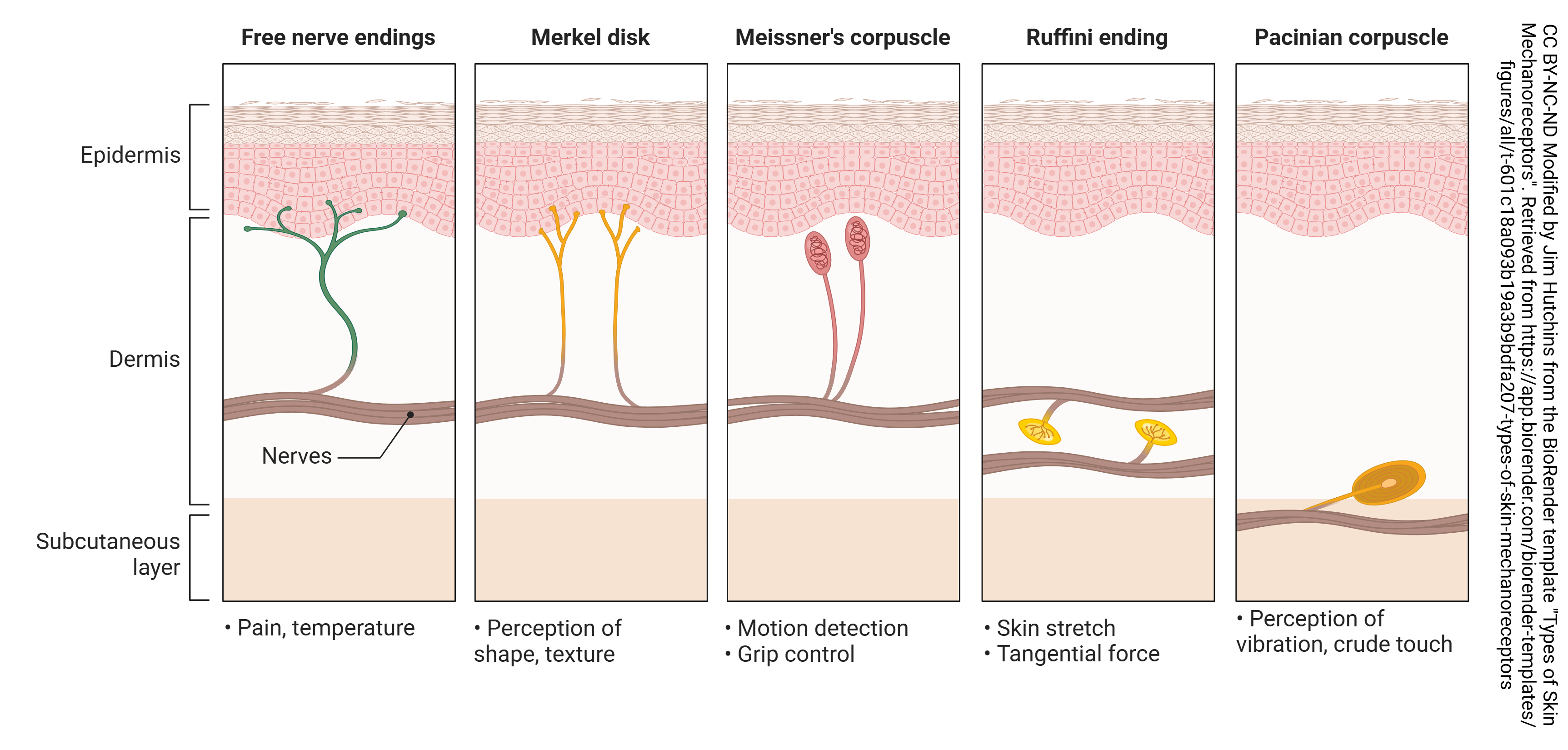
There are several types of sensory receptors in the skin which help take energy from the environment and convert it to a signal that the nervous system can use. We’ll look at these in more detail in Unit 12 of the HTHS 2111 course next semester.
For now, we need to recognize four types of sensory receptors in two locations.
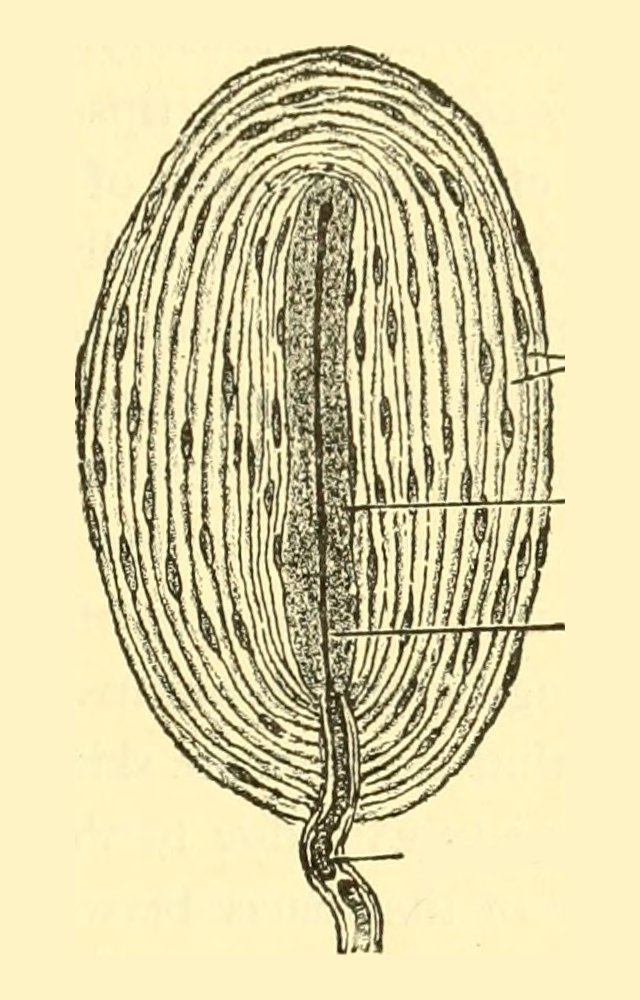
At the interface between epidermis and dermis, in the papillary region, are the Meissner corpuscles, Merkel discs, and free nerve endings. Meissner corpuscles and Merkel discs help us perceive light touch. Free nerve endings mediate painful sensations, feelings of hot or cold, and itch.
Deep in the skin, at the border of the dermis and the subcutaneous layer, is the Pacinian (lamellated) corpuscle. As the alternate name implies, these are layered like an onion. This special shape means that the nerve ending inside the corpuscle responds preferentially to vibration. It’s probably obvious why we need touch, pain and temperature receptors in skin. Why would we need a vibration receptor?
Scientists believe that the actual function of “vibration” receptors is to detect the slippage of thick skin (fingers and palm) against a surface, as when you lose your grip on a branch. As the hand slips, its alternate grabbing and slipping causes a vibration against the branch.
Ruffini endings, also called Ruffini corpuscles or bulbous corpuscles, detect deep, sustained pressure (such as someone’s grip on our arm during a scary movie, or a child holding your hand) and joint position sense. We will discuss joint position sense (proprioception) in Unit 12.
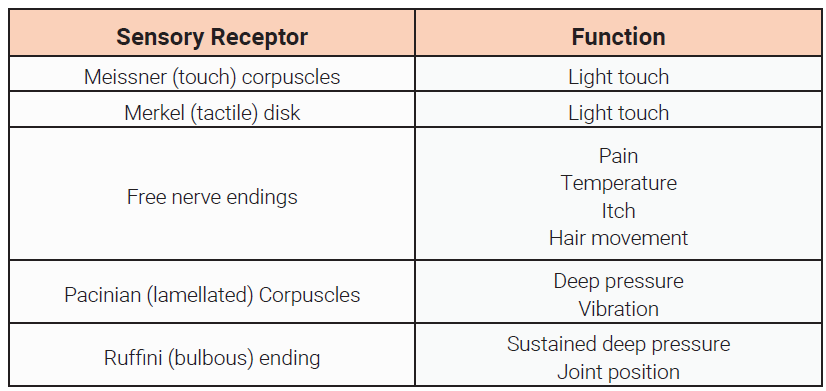
Sweat Glands
There are two kinds of sudoriferous (sweat) glands present in skin: eccrine and apocrine.
Eccrine sweat glands are needed as effectors in the homeostatic loops for thermoregulation (control of body temperature). The glands lie in the dermis and open to the skin surface through a duct. They secrete a sweat that is thin. This sweat is a dilute solution of salt water with traces of urea, uric acid, ammonia, amino acids, glucose, and lactic acid. The water is needed for evaporative cooling of skin. The other components are waste products being released. These glands are active throughout life.
Apocrine sweat glands were misnamed, but it’s too late to change the name. They were once thought to secrete product by an apocrine mechanism; we now know that’s not true and that they use a holocrine mechanism (Unit 7 Objective 4). The sweat produced by apocrine glands is similar to that produced by eccrine glands, but it is more viscous. They do not open to the skin, but are associated with hair follicles. They are stimulated to release their product during emotional stress and sexual excitement. The glands themselves lie in the subcutaneous layer, and there are traces of fat-soluble substances (such as pheromones) that participate in the sexual response. As you’d expect, they are not active until after the onset of puberty. Since apocrine sweat contains organic substances it is subject to bacterial decomposition and subsequent smell. Most commercial antiperspirants use an aluminum-based compound as their primary active ingredient to stop sweat. When the antiperspirant enters the sweat gland duct, the aluminum-based compounds precipitate due to a change in pH and form a physical block in the duct, which prevents sweat from coming out of the pore.
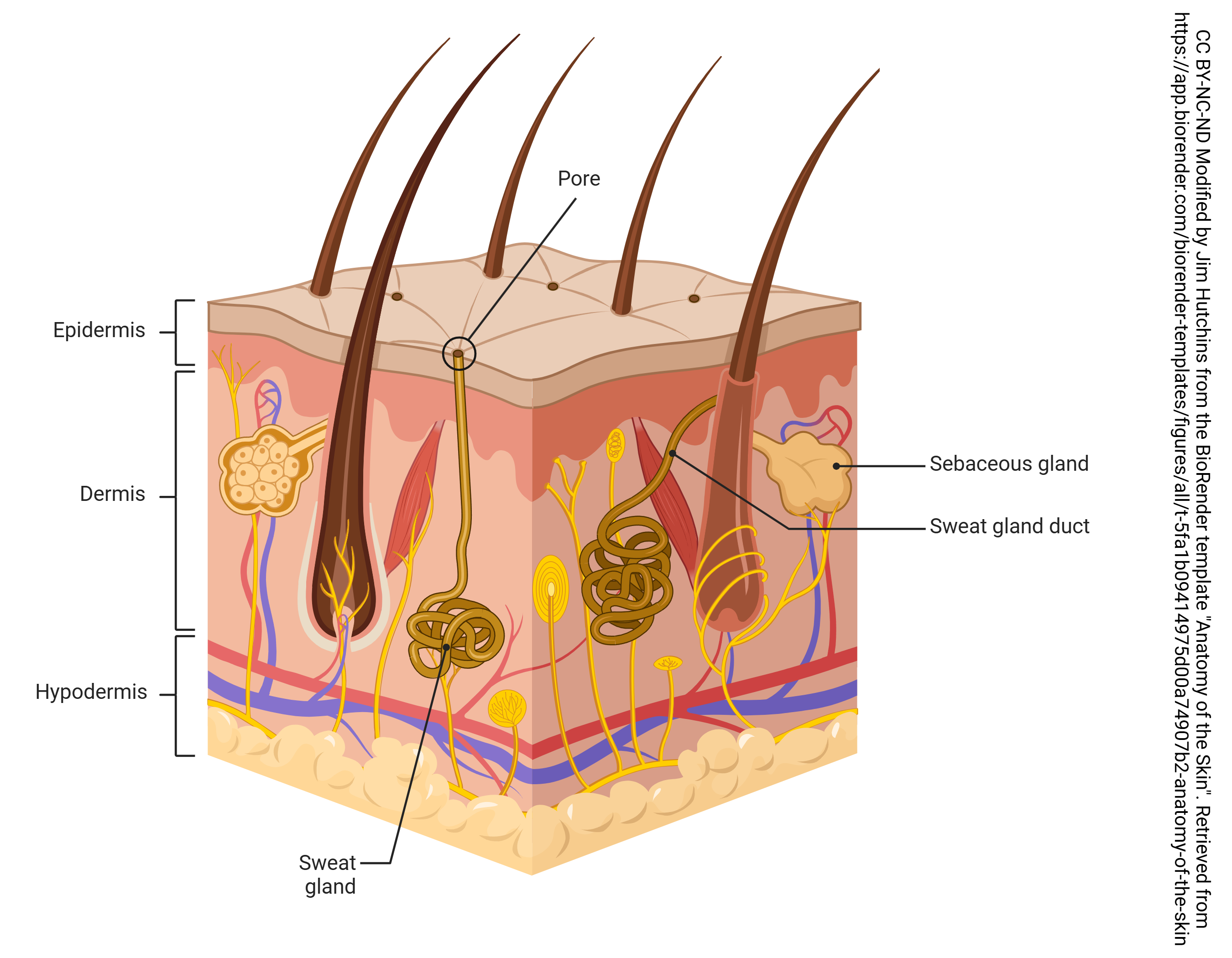
Sebaceous Glands
A sebaceous gland is a type of oil gland that is found all over the body and helps to lubricate and waterproof the skin and hair. Most sebaceous glands (oil glands) are found opening onto the neck of the hair follicle. Their oily secretion, called sebum, coats and protects the hair surface against drying and breakage. Sebaceous glands found on the lips, and other hair-free surfaces open directly onto the surface of the skin. They are absent on the palms of the hands and soles of the feet.
Sebaceous glands become active at puberty in response to androgens. (Both sexes produce androgens, but males typically produce more.) Acne is an inflammation of the sebaceous glands. Some types of bacteria like living in sebum, and acne occurs predominately in sebaceous follicles that are colonized by bacteria.
The anterior surface of the hands (palms and fingers) do not have hair, and are classified as thick skin. Thick skin is also called glabrous skin (Latin glaber, “hairless”). Remember that thick skin has a stratum lucidum while thin skin does not.
Along with differences in hair, there are differences in sweat glands. If you get nervous, your palms sweat; there are more sweat glands in thick skin than in thin skin.
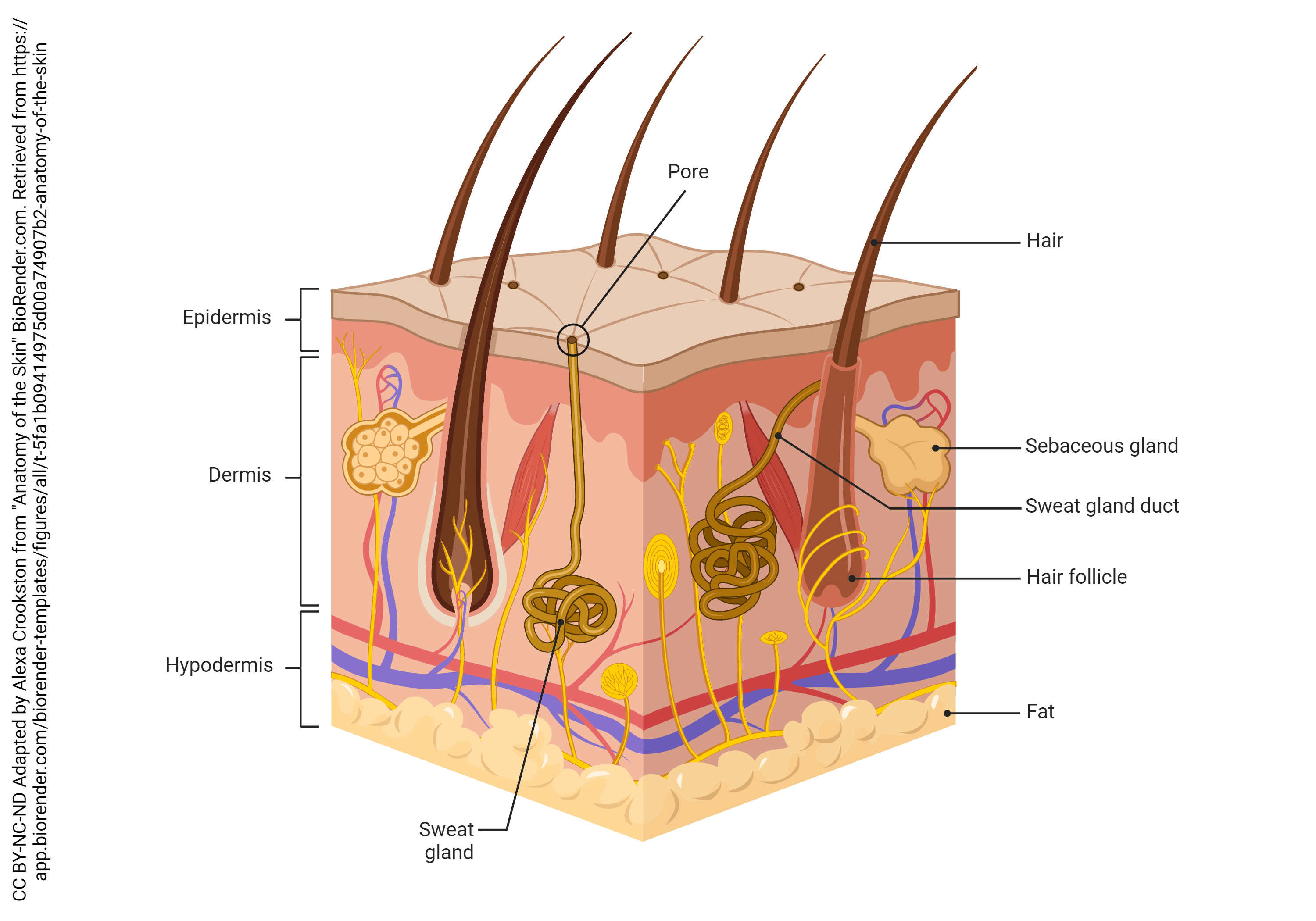
Because sebaceous glands are associated with hair follicles, they are present in hairy (thin) skin and absent in non-hairy (thick) skin.
The fingertips and lips are among the most sensitive parts of the human body. This is because they have the highest density of nerve endings.
Thick skin also has ridges because of the dermal papillae which underlie the epidermis. These specializations help increase grip and sensitivity on thick skin surfaces.
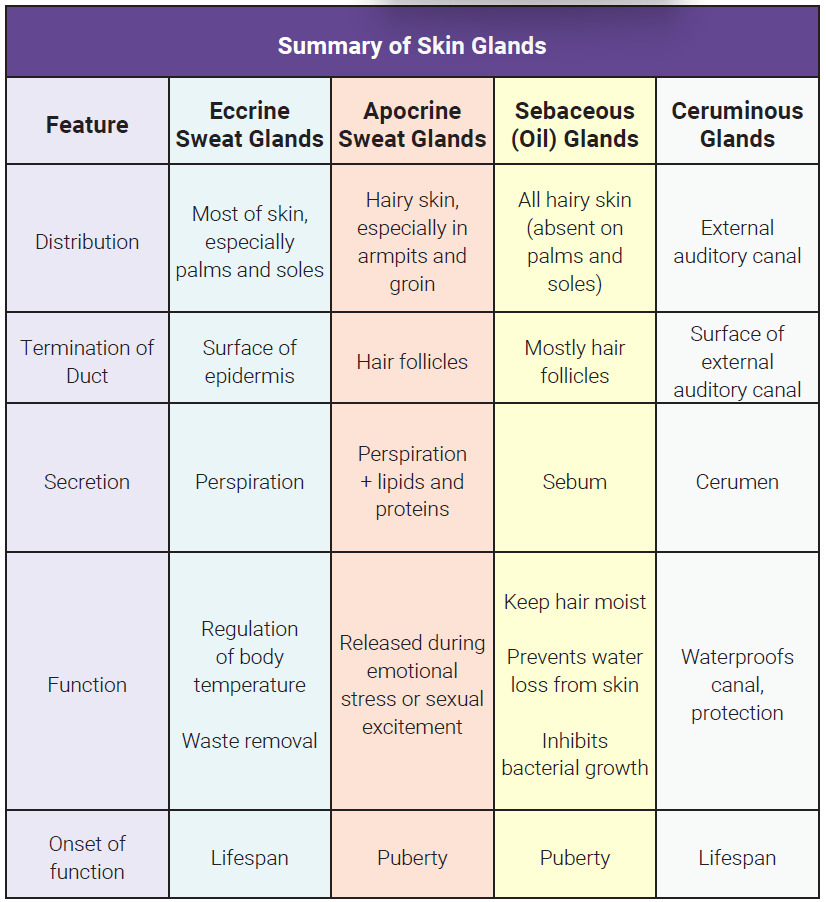
Media Attributions
- U08-020 Types of Skin Mechanoreceptors © Hutchins, Jim is licensed under a CC BY-NC-ND (Attribution NonCommercial NoDerivatives) license
- U08-021 lamellated corpuscle © Walter, Herbert Eugene and Sayles, Leonard Perkins is licensed under a Public Domain license
- U08-022 receptor table © Bizell, Lizz is licensed under a CC BY-SA (Attribution ShareAlike) license
- U08-023 Anatomy of the Skin_ Glands © Hutchins, Jim is licensed under a CC BY-NC-ND (Attribution NonCommercial NoDerivatives) license
- U08-024 Skin with Hair Follicles © Crookston, Alexa is licensed under a CC BY-NC-ND (Attribution NonCommercial NoDerivatives) license
- U08-025 skin glands table © Bizell, Lizz is licensed under a CC BY-SA (Attribution ShareAlike) license

